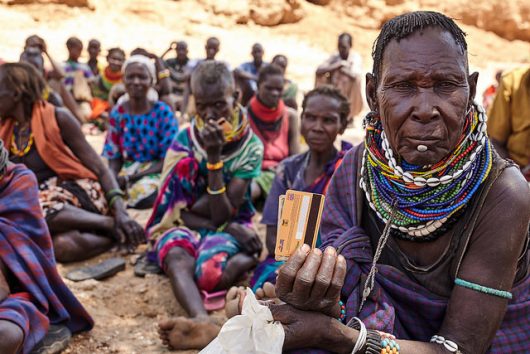How to Eradicate Extreme Poverty and Hunger

Poverty is like a cancer for society — it is debilitating and does not have a cure-all solution. People in extreme poverty live on less than $1.90 a day and face poverty traps due to factors such as geographic location, malnutrition, effort required to meet daily needs, lack of education and poor governance. With so many ways for people to become poor, it’s not surprising that different regions need to focus on different issues when determining how to eradicate extreme poverty and hunger.
Poverty Eradication Across the Globe
According to the 2017 World Bank Annual Report, Europe and Central Asia focused 41 percent of the $5.3 billion they borrowed from the International Bank for Reconstruction and Development as well as the International Development Association on energy and extractives but only two percent on education.
In contrast, South Asia concentrated 14 percent of the $6.1 billion they borrowed on energy and extractives, and 12 percent on education. Despite such disparities between these two countries’ prioritization of their energy and education sectors, both areas took action to build resilience to climate change, invest in human capital and improve infrastructure.
Benefits of Migration
For poor households trapped by low-productivity and in oftentimes remote, rural locations, migration could be a viable solution to increasing their standard of living. Such families may not be willing to migrate because it would put their sources of subsistence at risk. However, there are large potential gains from migrating to a highly productive country like the U.S.
According to a study by Clemens, Montenegro and Pritchett in 2016, the annual gain from working in a high-productivity environment is more than four times the total lifetime value of the most successful anti-poverty program.
Cash Transfer Solutions
On the policy side, well-targeted and structured cash transfers have been an increasingly popular tool for alleviating poverty in low-income countries. Cash transfers not only provide safety nets by raising the incomes of the poor, but they also help them escape from ‘psychological poverty traps.’
Contrary to the common concern that welfare programs can discourage work, a study done by Banerjee et al. in 2016 found no systematic evidence that cash transfer programs affect the overall number of hours worked nor the propensity to work among the men and women in the seven programs carried out in the Honduras, Indonesia, Morocco, Mexico (which had two programs), Nicaragua and the Philippines.
There are also solutions that require the consideration of measuring poverty based on other factors besides income and consumption. One example would be the offshoring of low-skilled jobs. While these jobs do provide a steady source of income, they are often also unpleasant, risky and may lead to adverse health effects. So, although these jobs can provide a short-term safety net, they are not a long-term solution to poverty.
Small Changes, Big Outcomes
Specific strategy government programs that have lasting effects countering poverty involve multifaceted household-level interventions. In one study by Banerjee et al., implementation of an anti-poverty program at the household level in India, Ethiopia and Pakistan (as well as both the village and household level in Ghana, Honduras and Peru) led to at least a year’s worth of lasting impact after the short-term intervention of the program.
Statistically significant impacts were made in the areas of consumption, food security, productive and household assets, financial inclusion, time use, income and revenues, physical health, mental health, political involvement and women’s empowerment. The intervention consisted of six elements: a productive asset grant, temporary cash consumption support, technical skills training, high frequency home visits, a savings program and health education and services.
Pros and Cons of Policy Change
On the other hand, governments also need to be careful when deciding on policies that involve low-income countries. Bill Clinton admitted in 2010 that his policy to dump American tariff-free rice in Haiti was a mistake. By forcing Haiti to drop tariffs on imported subsidized U.S. rice, the damage done to rice farming severely hindered Haiti’s ability to be self-sufficient.
In response to the incident, Oxfam recommended that food aid should be bought in local markets inside the country receiving aid.
Oxfam also said the Haitian government should decentralise services away from the capital, make sure farmers have credit access and improve their land tenure system where farmers could be cheated by judges able to transfer land into the hands of ‘whoever offers the biggest bribe.’
Eradicating Extreme Poverty and Hunger
The same goes for humanitarian organizations in deciding what kinds of resources and assistance to provide. To answer the question of how to eradicate extreme poverty and hunger, these organizations need to first determine what consequences their intervention would lead to. By looking for methods to complement local capacities to combat poverty, humanitarians can prevent their efforts from displacing local businesses.
A great example is The Hunger Project — a global nonprofit organization dedicated to ending world hunger. With programs throughout Africa, South Asia and Latin America, this organization empowers women and men in rural villages to sustainably overcome hunger and poverty. Members of the community accomplish this feat by mobilizing and fostering effective partnerships to engage local government.
In conclusion, there are many factors to consider in different parts of the world when looking at how to eradicate extreme poverty and hunger. Auspicious solutions to poverty traps include migration, conditional cash transfers and multifaceted household-level programs. On the side of humanitarian organizations and the government, much deliberation is essential to providing goods, services and policies that complement and protect rather than displace local needs and markets.
– Connie Loo
Photo: Flickr
